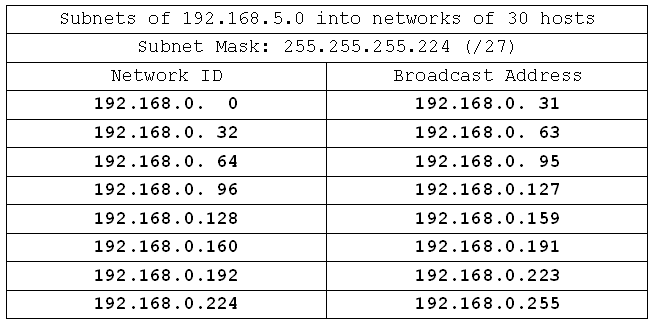

Many times there isn't one right way to subnet a block. You haven't given enough information to calculate subnets for this network as a general rule you build subnets by reallocating some of the host bits as network bits for each subnet. This means our host bits are the last 11 bits of the IP address, because we find the host mask by inverting the network mask: Host bit mask : 00000000 00000000 00000hhh hhhhhhhh The broadcast address converts all host bits to 1s. Align the bits in both addresses, and perform a logical AND on each pair of the respective bits. The network address is the logical AND of the respective bits in the binary representation of the IP address and network mask. the left-hand-side of the binary number). Then, count the number of contiguous 1 bits, starting at the most significant bit in the first octet (i.e. We are still not finished though, we need to account for the broadcast address and the network address.Calculating the Netmask Length (also called a prefix):Ĭonvert the dotted-decimal representation of the netmask to binary. Now the third part is easy again we take how many subnet bits we have, 25 and use this number to subtract against 32, as you can see 32 – 25 = 7Īgain using our powers of 2 strategy 7^2 = 128 What about the fourth octet? Same rules apply. So for 255.255.255.128 we can subtract 256 by 255 for our third octect or we can just memorize that all bits and numbers can be used. We use our magic formula of 256 – our decimal format.

So we use the following formula: 2^9 = 512 Now we subtract our subnet by the classful subnet and get: 25-16 = 9 How do we get this? – We derive this by looking at the amount of subnet bits we can use based on our mask so we count the extra bits by putting our subnet mask of 255.255.255.128 and convert it to a CIDR notation 255(8). We need to know which bits were are going to use though.

CLASSFUL SUBNETTING CHART FREE
The first part is easy – we know that 172.16.0.0/16 – has 16 whole bits free for subnetting. (A) How many subnets would you have? (B) What are the valid subnets? (C) How many hosts will be allowed? Here are some Classful Subnetting tricks that I learned while preparting for my CCNA Cert – I’m sure that brushing up on these can’t hurt anything.Īny time that you break these down you are subnetting – so an example question would be if you have a subnet mask of 255.255.255.128 and you are subnetting 172.16.0.0


 0 kommentar(er)
0 kommentar(er)
